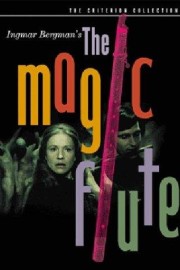The Magic Flute
Ingmar Bergman’s “The Magic Flute” begins with a flurry of faces. One after another, onlookers to an event as the orchestra plays the Overture to Mozart’s beloved opera. Since we know from critics like Roger Ebert that Bergman considered the face the most important subject of the cinema, this could not be a more appropriate opening for Bergman’s film, unquestionably his most delightful.
Rather than adapt Mozart’s masterwork as a truly cinematic experience, liberating it from the stage and creating a genuine fantasy from the story of the young hero Tamino (Josef Kostlinger) and his journey to save the princess Pamina (Irma Urrila) from an evil sorcerer (with real locations as a Hollywood filmmaker might do), Bergman keeps the opera on the stage, and lets his master cinematographer Sven Nykvist use his camera to make the story (as adapted by Bergman) come alive on the screen. The result is breathtaking, beautiful, and passionate.
And funny. Not just in substance but in tone. There’s a self-consciousness to the production at times that is surprising when you compare it to Bergman’s more profound films, be it “The Seventh Seal” or “Persona” or “Wild Strawberries” and “Scenes From a Marriage.” Well, maybe not too surprising; like other foreign filmmakers (Tarkovsky comes to mind), Bergman wasn’t afraid to break the fourth wall between audience and film in ways that only deepened the experience in the memory. Here, he occasionally has his characters cue for printed lyric cards to come into frame during important thematic passages. It’s a sly nod to the viewer, as well as a way of keeping the story from getting too serious. It’s like Bergman (after the gut-wrenching stories of “Scenes From a Marriage” and “Cries and Whispers,” his films immediately prior to “The Magic Flute”) needed to express all of the joy he had pent up inside in this one film, and was determined to find any way he could to make it come out.
But back to the production itself. I mentioned that Bergman made the decision to stage the film as it might be seen in an opera house, and that holds true throughout (we even see the sides of the stage, and performers getting prepared off-stage to go on– another nod by Bergman to the audience). However, there are times when the illusion of the stage is broken down and we appear to be on real sets, as they might for a film like “Lord of the Rings” and “Harry Potter.” There’s simply no way we can see that such images (like the on-screen debut of Sarastro and his legions) could exist on the stage as we’ve seen it, but it doesn’t matter; for Bergman, the most important thing isn’t the plausibility of the illusion but the drive of the narrative. Bergman trusts in the music of Mozart and libretto by Schikaneder (who produced a famous production of the opera in 1791) to keep our interest. It’s a wise decision– Mozart’s story is a fascinating one, and his music (as conducted by Eric Ericson and performed by the Swedish Radio Symphony Orchestra) is energetic, emotional and inspiring.
In the end, good triumphs over evil, and we get a happy ending (a rarity in Bergman’s work). There are so many wonderful moments: the three angels who intervene when Pamina contemplates suicide in the snowfall; Papagino’s joy at the possibility of having a love of his own, as well as his despair when he’s unsure he’ll get to meet her; Tamino’s pain at having to be silent to his beloved as he faces the trial; the animals coming towards Tamino when he first plays the magic flute; the backstage moments with a young boy at intermission, witness to all that is going on as the performers prepare for Act II. But as with all of Bergman’s films, it comes down to the faces; in this case, the face of a young girl in the audience Bergman cuts to scene after scene, the joy and fascination on her face as she watches Mozart’s wonderful opera unfold. That face belongs to Bergman’s own daughter; even when he isn’t dealing with the more sober truths of life and man’s spirituality, the master filmmaker still found a way to make his art personal, and powerful. It also makes his “The Magic Flute” an unadulterated pleasure to watch.










